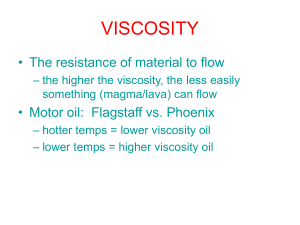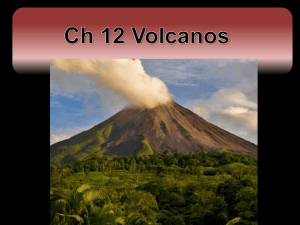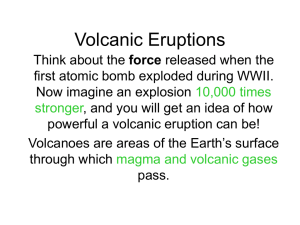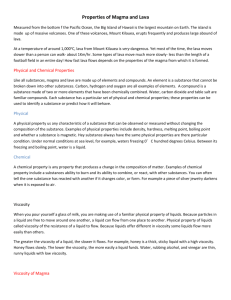Volcano - Waterford Public Schools
advertisement
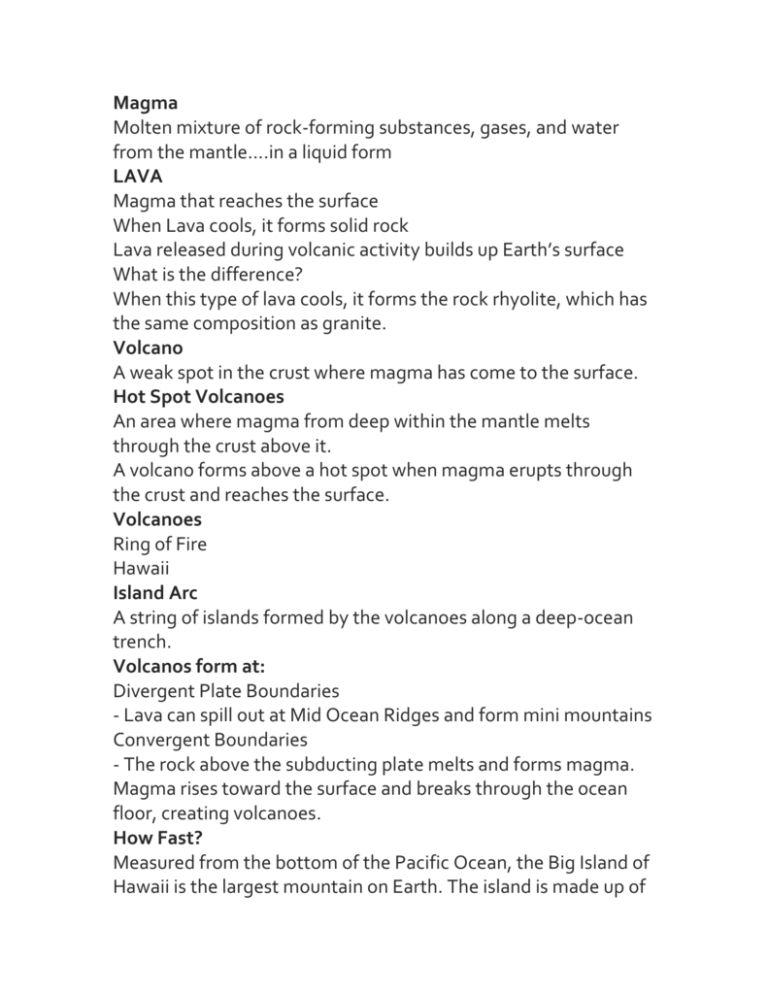
Magma Molten mixture of rock-forming substances, gases, and water from the mantle....in a liquid form LAVA Magma that reaches the surface When Lava cools, it forms solid rock Lava released during volcanic activity builds up Earth’s surface What is the difference? When this type of lava cools, it forms the rock rhyolite, which has the same composition as granite. Volcano A weak spot in the crust where magma has come to the surface. Hot Spot Volcanoes An area where magma from deep within the mantle melts through the crust above it. A volcano forms above a hot spot when magma erupts through the crust and reaches the surface. Volcanoes Ring of Fire Hawaii Island Arc A string of islands formed by the volcanoes along a deep-ocean trench. Volcanos form at: Divergent Plate Boundaries - Lava can spill out at Mid Ocean Ridges and form mini mountains Convergent Boundaries - The rock above the subducting plate melts and forms magma. Magma rises toward the surface and breaks through the ocean floor, creating volcanoes. How Fast? Measured from the bottom of the Pacific Ocean, the Big Island of Hawaii is the largest mountain on Earth. The island is made up of massive volcanoes. One of these volcanoes, Mount Kilauea (kee loo ay uh) erupts frequently and produces huge amounts of lava. At a temperature of around 1,000°C, lava from Mount Kilauea is very dangerous. Yet most of the time, the lava moves slower than a person can walk—about 1 kilometer per hour. Some types of lava move much more slowly—less than the length of a football field in an entire day. Properties of MAGMA Physical Properties What is a physical property? 700-1300 degrees Celcius Bright Red, Black, Orange, Yellow Chemical Properties What is a chemical property? Chemical Composition Made up of at least 10 elements Silicon(Si), Titanium (Ti), Aluminum (Al), Iron (Fe), Magnesium (Mg), Calcium (Ca), Sodium (Na), Potassium (K), Hydrogen (H) and Oxygen (O). Amount of Heat Viscosity The resistance of a liquid to flowing. Because liquids differ in viscosity, some liquids flow more easily than others. Silica (Silicon and Oxygen) determine viscosity More Silica= greater viscosity produces light colored lava A decrease in temperature increases viscosity Shield Volcanoes A wide, gently sloping mountain made of layers of lava and formed by quiet eruptions. Cinder Cone Volcano A steep, cone-shaped hill or small mountain made of volcanic ash, cinders, and bombs piled up around a volcano’s opening Composite (Stratovolcano) A tall cone-shaped mountain in which layers of lava alternate with layers of ash and other volcanic materials. Quiet Eruptions magma is low in silica gases in magma bubble gently lava oozes quietly and can flow for many kilometers build up islands over hundreds and thousands of years for example, the Hawaiian islands Explosive Eruptions magma is high in silica magma does not always flow out of the crater gets stuck/plugs up volcano the gases from the magma create pressure and eventually erupt! Low Silica Quiet Eruptions Low viscosity Easy flow High Silica Explosive Eruption High Viscosity Thick and Sticky The color of lava depends on its temperature. Bright Orange --> 1000-1150 C Bright Red --> 800-1000 C Dark Red --> 650-800 C Brownish Red --> 500-650 C Black --> solid lava/rock (but can still be very hot). Lava Color Stages of Volcanoes 1) Active -erupting or has shown signs that it may erupt in the near future 2)Dormant -A volcano that is not currently active, but may become active in the future. 3) Inactive -dead, unlikely to erupt again




